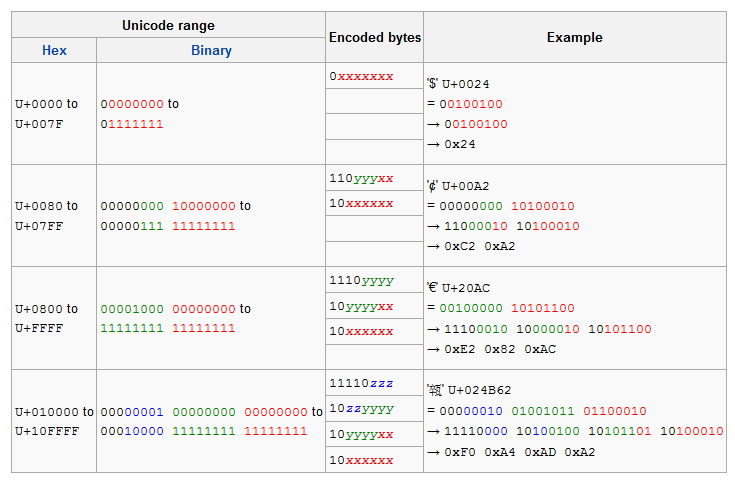首页 > 代码库 > 检测字节流是否是UTF8编码
检测字节流是否是UTF8编码
几天前偶尔看到有人发帖子问“如何自动识别判断url中的中文参数是GB2312还是Utf-8编码”
也拜读了wcwtitxu使用巨牛的正则表达式检测UTF8编码的算法。
使用无数或条件的正则表达式用起来却是性能不高。
刚好曾经在项目中有类似的需求,这里把处理思路和整理后的源代码贴出来供大家参考
先聊聊原理:
UTF8的编码规则如下表

看起来很复杂,总结起来如下:
ASCII码(U+0000 - U+007F),不编码
其余编码规则为
?第一个Byte二进制以形式为n个1紧跟个0 (n >= 2), 0后面的位数用来存储真正的字符编码,n的个数说明了这个多Byte字节组字节数(包括第一个Byte)
?结下来会有n个以10开头的Byte,后6个bit存储真正的字符编码。
因此对整个编码byte流进行分析可以得出是否是UTF8编码的判断。
根据这个规则,我给出的C#代码如下:
/// <summary>/// Determines whether the given <paramref name="inputStream"/>is UTF8 encoding bytes./// </summary>/// <param name="inputStream">/// The input stream./// </param>/// <returns>/// <see langword="true"/> if given bystes stream is in UTF8 encoding; otherwise, <see langword="false"/>./// </returns>/// <remarks>/// All ASCII chars will regards not UTF8 encoding./// </remarks>public static bool IsTextUTF8(ref byte[] inputStream){ int encodingBytesCount = 0; bool allTextsAreASCIIChars = true; for (int i = 0; i < inputStream.Length; i++) { byte current = inputStream[i]; if ((current & 0x80) == 0x80) { allTextsAreASCIIChars = false; } // First byte if (encodingBytesCount == 0) { if ((current & 0x80) == 0) { // ASCII chars, from 0x00-0x7F continue; } if ((current & 0xC0) == 0xC0) { encodingBytesCount = 1; current <<= 2; // More than two bytes used to encoding a unicode char. // Calculate the real length. while ((current & 0x80) == 0x80) { current <<= 1; encodingBytesCount++; } } else { // Invalid bits structure for UTF8 encoding rule. return false; } } else { // Following bytes, must start with 10. if ((current & 0xC0) == 0x80) { encodingBytesCount--; } else { // Invalid bits structure for UTF8 encoding rule. return false; } } } if (encodingBytesCount != 0) { // Invalid bits structure for UTF8 encoding rule. // Wrong following bytes count. return false; } // Although UTF8 supports encoding for ASCII chars, we regard as a input stream, whose contents are all ASCII as default encoding. return !allTextsAreASCIIChars;} |
再附上单元测试代码:
/// <summary>///This is a test class for EncodingHelperTest and is intended///to contain all EncodingHelperTest Unit Tests///</summary>[TestClass()]public class EncodingHelperTest{ /// <summary> /// Normal test for this method. ///</summary> [TestMethod()] public void IsTextUTF8Test() { for (int i = 0; i < 1000; i++) { List<Char> chars = new List<char>(); chars.Add(‘中‘); List<UnicodeCategory> temp = new List<UnicodeCategory>(); Random rd = new Random((int)(DateTime.Now.Ticks & 0x7FFFFFFF)); for (int j = 0; j < 255; j++) { char ch = (char)rd.Next(0xFFFF); UnicodeCategory uc = System.Globalization.CharUnicodeInfo.GetUnicodeCategory(ch); if (uc == UnicodeCategory.Surrogate || // Single surrogate could not be encoding correctly. uc == UnicodeCategory.PrivateUse || // Private use blocks should be excluded. uc == UnicodeCategory.OtherNotAssigned ) { j--; } else { chars.Add(ch); temp.Add(uc); } } string str = new string(chars.ToArray()); byte[] inputStream = Encoding.UTF8.GetBytes(str); bool expected = true; bool actual; actual = EncodingHelper.IsTextUTF8(ref inputStream); Assert.AreEqual(expected, actual, string.Format("UTF8_Assert Fails at:{0}", str)); inputStream = Encoding.GetEncoding(932).GetBytes(str); expected = false; actual = EncodingHelper.IsTextUTF8(ref inputStream); Assert.AreEqual(expected, actual, string.Format("ShiftJIS_Assert Fails at:{0}", str)); } } /// <summary> /// Check with All ASCII chars /// </summary> [TestMethod] public void IsTextUTF8Test_AllASCII() { string str = "ABCDEFGHKLHSJKLDFHJKLHAJKLSHJKLHAJKLSHDJKLAHSDJKLHAJKLSDHJKLASHDJKLHASJKLDHJKLASD"; byte[] inputStream = Encoding.UTF8.GetBytes(str); bool expected = false; bool actual; actual = EncodingHelper.IsTextUTF8(ref inputStream); Assert.AreEqual(expected, actual, string.Format("UTF8_Assert Fails at:{0}", str)); }} |
另:
如果是判断一个文件是否使用了UTF8编码,不一定非用这种方法,因为通常以UTF8格式保存的文件最初两个字符是BOM头,标示该文件使用了UTF8编码。
参考:
维基百科:http://en.wikipedia.org/wiki/UTF-8
检测字节流是否是UTF8编码
声明:以上内容来自用户投稿及互联网公开渠道收集整理发布,本网站不拥有所有权,未作人工编辑处理,也不承担相关法律责任,若内容有误或涉及侵权可进行投诉: 投诉/举报 工作人员会在5个工作日内联系你,一经查实,本站将立刻删除涉嫌侵权内容。
